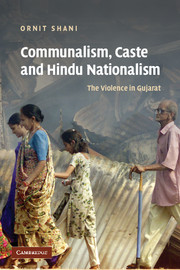Part II - The 1985 Ahmedabad riots: the historical conjunction between caste conflicts and communalism
Published online by Cambridge University Press: 04 December 2009
Summary
Outlining the riots – the plot
Seven months of ferocious large-scale riots in the city of Ahmedabad started in February 1985 with the death of a bus passenger who was burnt alive as a group of protesting students set fire to a State Transport bus, along with the injuring of eight policemen during a violent demonstration. The riots erupted over the decision of the Gujarat state government to increase the reserved quotas for backward-caste Hindus in educational institutions and government jobs from 10 per cent to 28 per cent. Upper-caste Hindus started the agitation against the state policy. Startlingly, within a month, the intra-Hindu caste dispute turned into communal violence between Hindus and Muslims. Communal uproar spread throughout the city. The army was called in, but the waves of outrage continued. The police force also became embroiled in the agitations. The spree of violence persisted with unprecedented stabbings, and the looting and burning of houses and shops. Most of the victims were Muslims. Bomb blasts hit the city. The newly elected Chief Minister resigned because of the government's inability to bring the situation under control. Moreover, the state was paralysed by a massive government employee strike. Finally, after seven months of anti-reservation agitation and catastrophic communal violence the riots gradually abated.
When the new reservation policy was announced by the Gujarat government in January 1985 there was at first no overt reaction from the upper castes.
- Type
- Chapter
- Information
- Communalism, Caste and Hindu NationalismThe Violence in Gujarat, pp. 77 - 88Publisher: Cambridge University PressPrint publication year: 2007



